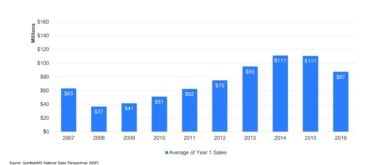Brentwood is a quaint, French-inspired bistro in Little River, South Carolina famous for its seven-course dining experiences. The award-winning chef, Eric Masson, describes “it’s not a meal, it’s a journey.” Each culinary adventure at Brentwood begins with a light, seasonal surprise to whet the palate. Then, the first course tantalizes with a gently seasoned seafood selection, such as caviar with warm blinis and crème fraiche followed by a slightly heavier protein like seared duck foie gras with caramelized apple and an aged balsamic glaze. Taste buds buzzing, you continue to be expertly guided through an increasingly complex tour of beautifully composed flavors, concluding with a decadent dessert.
With the visual displays, the intoxicating aromas, the weave of textures, and calculated flavor profiles that draw the diner through from first forkful to last, Brentwood’s meal truly is a journey for the senses.
A bit of a foodie myself, I think of multichannel marketing (MCM) in a similar way—minus the calories. Like Brentwood’s seven courses, MCM programs should take customers down a path that consists of increasingly more relevant engagement at every turn, concluding with a sweet reward. Some industries, such as retail and travel, get it and have invested in the technology to do it right.
Here’s an example: Every three months, I receive an offer via email from my favorite airline coinciding with my quarterly trip to San Francisco. From that email, I can easily click to the website and book a discounted flight. Next (course), I get an offer to upgrade my seat through my mobile app, which I gladly accept. The day of the flight, I may get a text message that my flight is delayed but it includes an invitation to the executive lounge where I’m greeted with a drink and a smile. When I arrive home, I have a special offer for a future flight waiting for me. These are not random messages sent via different channels, but rather carefully choreographed communications that map to my history and then build on each previous interaction to appropriately deliver messages through channels most convenient to me. It’s a seamless flow of conversation across channels, culminating in a compelling offer.
Why Pharma’s MCM Approach is Undercooked
The life sciences industry still struggles to succeed with MCM. It’s understandable, especially considering the dozens of new channels now at our disposal. What does a successful customer engagement model look like today? What’s the right promotional mix … the ideal customer journey … the perfect targets?
It’s time to take a fresh look at MCM. Let’s think like a five-star restaurant chef about how to blend the right flavors together and in the right order for well-balanced customer interactions, rather than just sending more and more messages via more and more channels. The life sciences industry has historically focused on the frequency of interactions and has adopted this mentality across the new channels available today. In fact, ZS Associates found that the top 5% of customers of one large pharmaceutical company were averaging more than 120 touches each annually across all brands and channels.1 Were these communications coordinated? Did they build on one another? Were the sales rep and brand teams in sync with each interaction? Or even know what the other was communicating?
Unlikely. Creating that perfect alignment between the content and the channel it is delivered in is difficult to achieve today as most life sciences companies lack a complete view of the customer. Data from a digital campaign may sit with the agency partner who managed it. Data from a face-to-face interaction, however, may reside in the company’s CRM system. The two sources never come together.
“Lack of alignment between sales and marketing, uncoordinated channel management, and fragmented channel data are right now among the biggest barriers to implementing a thoughtful multichannel marketing program in life sciences,” said Pratap Khedkar, Managing Principle of ZS Associates.1
Without a comprehensive view of all customer data, it’s practically impossible to determine the impact of one channel versus another or to understand customer needs in full. Instead, what’s left is a series of disconnected, one-and-done promotions that are not synchronized and do not mesh directly with a customer’s evolving needs or information gained from past interactions. This disjointed multichannel approach inevitably frustrates or even turns the customer off completely. In contrast, orchestrated communications result in a better experience—and the impact of each subsequent interaction compounds the overall effect. Like the airline example, every communication is in perfect harmony with the customer throughout his journey.
According to a 2014 Manhattan Research survey, “74% of ePharma physicians are interested in following up as a result of engaging with a pharma sales rep using a tablet.”2 In fact, companies that engage in face-to-face interactions, followed by an email to that customer, experience better email open rates than if the same channels are used independently—3% vs. 40%. The number of customer touch points also increases in quality and quantity when customers are given a reason to click—say, from a link in an email that takes the customer to a web page for detailed information. Each channel working together becomes dramatically more effective than any one used alone. Just as a single interaction will not convert a customer into an advocate, it takes a carefully coordinated, multi-touch campaign. The result is a crescendo of customer interactions that, over time, build long-term relationships.
Meeting High Expectations
Customers today demand more because they are used to getting more, such as watching high-definition TVs that also stream movies on demand and let you check email. They expect seamless, personalized service and access to information anytime, from anywhere, using any device. They want to start a conversation in one channel, and continue it in another. After all, they can deposit money using an ATM, immediately use a mobile phone to check the account balance, and then go to a website to transfer funds to another bank. Multiple channels that are not connected cannot deliver such a perfectly calibrated multichannel experience. It’s the key difference between having multiple channels, and providing true multichannel engagement.
Traditionally, it was very hard to align all of life sciences’ customer-facing resources: Sales, marketing and medical. With cloud technology, it is easier to coordinate activities across all teams and channels and deliver the right information that meets your customer’s evolving needs. In the cloud, actual customer insights (not derived from an industry survey) can be captured in real time and made accessible to all stakeholders to inform their MCM strategies. Here’s how two companies transformed their commercial operations to successfully execute multichannel strategies.
Lundbeck Pharmaceuticals
Lundbeck Pharmaceuticals recently remodeled its global commercial operations to harmonize best practices for customer engagement worldwide. The company began by establishing a cloud-based technology foundation for sales and marketing that would enable a more customer-centric culture. With its cloud platform, Lundbeck gathers and aggregates rich customer insights across personal and non-personal channels, including channel preference data that informs the company’s global commercial strategy. As a result, the company is enhancing face-to-face meetings with relevant interactive content displayed on tablets and enabling the conversation to continue over time with rep-sent emails fueled by approved content to avoid compliance risk.
“In the cloud, we now have a way to communicate with our customers across multiple channels,” notes Lundbeck U.S. Director of Sales Operations and Technology George Sfondilis. “We see how every customer touch point aligns for the big picture. By bridging IT, marketing, medical and sales, our solution enables fully synchronized multichannel execution.”
Tim White, Lundbeck’s Senior Director and Head of Global Customer Interaction Management, adds, “From a marketing perspective, customer data is imperative. It shapes everything—investments, strategy, messaging and more. With our commercial cloud platform, we benefit from the right information from every interaction, and can then easily share those insights across the organization to improve the customer experience with every subsequent interaction. It enables us to focus on most effectively leveraging the right channels for each doctor and accelerate our path toward customer centricity.”
Keryx Biopharmaceuticals
With the U.S. Food and Drug Administration’s (FDA’s) approval of Auryxia (Ferric Citrate), Keryx Biopharmaceuticals needed to quickly build a commercial foundation for product sales and marketing. Keryx required a best-of-breed solution that would enable business agility and continuous improvement, plus easily accommodate change and rapid growth. The company began product commercialization planning with a blank slate and a simple goal: To best enable its field teams and provide a differentiated customer experience.
“We have adopted a holistic, customer-centric strategy by implementing a cloud platform that enables information sharing between sales, marketing and medical affairs enterprise-wide,” says Keryx Vice President of Marketing and Operations Abraham Ceesay. “We can now develop relevant multichannel programs that allow us to engage with customers on their terms.”
Matt Nestor, Keryx Director of Commercial Operations, adds, “Today, our sales reps can hold ongoing conversations with customers across all channels for a seamless customer journey. Emails including approved marketing content allow reps to follow up on conversations or start new ones using the latest materials without compliance risk. And, our cloud-based CLM application feeds insights from the field directly to marketing, and vice versa, for harmonized, more successful selling. Having a complete view of the customer’s experience with the rep—including pre-call, in-call and post-call activities—in a single solution enables us to create a premier sales force that’s laser-focused on customer needs.”
Two Key Ingredients to Multichannel Success
First, stop thinking about the sales rep’s involvement as an “either/or” scenario: Either the sales rep makes a visit or a marketer sends an email. Sales reps should always be involved and be given the visibility they need to have more informed calls and make the best next decision. The temptation with multichannel strategy is to substitute new channels for the rep. Sure, you may not use reps for some segments, but for most segments, it’s dramatically more impactful to mix traditional, personal channels with new digital ones not just to get scale but to also fully meet customer needs.
Second, don’t over-engineer the channel mix. With nearly 50 channels available to consider in a multichannel strategy, the question isn’t which channels are the best. Rather, ask yourself, “What is the best progression of channel communications,” based on customer preference and affinity. Define a simple strategy (i.e., face to face + rep-driven email + web), and then get started. Use the resulting data to determine customer needs and affinity, and then tweak messaging and resource allocation based on what you learn. It will be a continuous cycle of improvements based on real customer information for better results.
Like a fine dining experience, the goal for multichannel should always be to take the customer along on a journey that builds toward a trusted, long-term relationship—the pièce de résistance!
References:
1. Pharmaceutical Commerce, “Getting from Multichannel Marketing to Customer-Centric Marketing,” by Pratap Khedkar, ZS Associates. March/April 2014.
2. Manhattan Research, “ePharma Physician Survey,” 2013.







